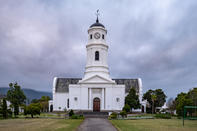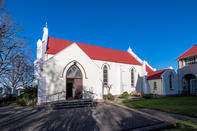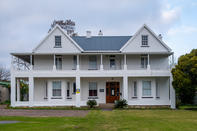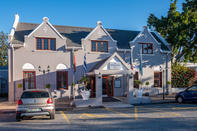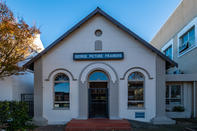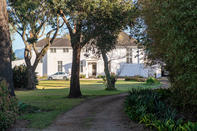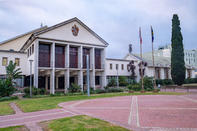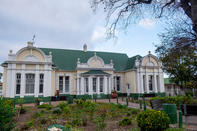As George is the 6th oldest town in the country, it boasts numerous historical buildings, with some dating back to the early 1800s. Many of the buildings form part of the George Heritage Trust, which looks to promote sustainable conservation of the architectural, archeological, cultural/living and natural heritage of George and the surrounding district.
Holy Trinity
The Holy Trinity consists of the Dutch Reformed Church, St Mark's Cathedral, which is the Anglican Church and the Roman Catholic Parish of St Peter & Paul. Each building has a unique architectural style and representation.
The Dutch Reformed Mother Church started construction around 1830, and was completed in 1842. It is a lovely landmark of George, standing tall against the magnificent backdrop of the Outeniqua Mountain. Its is within walking distance of several shops and restaurants in town, so visitors can immerse themselves in the history of the area. It is a provincial heritage site.
St Mark’s Cathedral is a tiny Anglican Church that was built from local stone in 1850. It was designed by Sophy Gray, who was the wife of a prominent figure in the Garden Route, Bishop Robert Gray. It was granted cathedral status in 1911, and the building itself has been extended over the years, with added features such as the Chancel and Apse, as well as the Lady Chapel and Chapter House.
The St Peter and Paul Roman Catholic Church was established in 1841, and completed in 1843 by Father Aiden Devereux. It is the oldest Roman Catholic Church in South Africa, and boasts as a beautiful piece of historic architecture.
Town Houses
As George grew into a town, many settlers opted to build a family house on their property for the next generation to live and thrive in. One such example is 120 York Street, which was owned by the district’s surgeon Dr Charles Owen-Snow. He built Lache House on the property in 1903, and went on to own the town’s first motor car. 123 York Street dates back to 1814, when the first magistrate of George, Adrianus van Kervel, settled on the property. In 1900 it became the Gables Guest House, run by the van Niekerk sisters. The Tourell family bought the property in 1948 and changed it to the Outeniqua Hotel. Then in 1995, the Kritzas and Chryssomallos families rebuilt the building in the original Gales style. It is now the Outeniqua Protea Hotel.
91a Meade Street has been home to many trades. It was first owned by town councillor de la Harpe in 1836, and was then occupied by a Dutch mission school in 1870. It also served as the Salvation Army chapel and barracks. In 1955 it was sold to the George Baptist Church, and was put to commercial use in 1990 - first as an interior design office, and now a picture framing business.
Bishops Lea is another renowned building in George, designed by the famous Sir Herbert Baker under his partnership Kendall & Baker. Although the great architect returned to England before the building was completed in 1913, he played a big part in ensuring it was architecturally sound.
Other Buildings
The Centenary Hall was designed by architects Simpson & Bridgeman in a neo-baroque style. It was used in 1911 to mark the centenary of the founding of the town. The Arts Theatre in George was designed by Charles Bullock in 1905 and originally used as a public school for girls. In 1969 it opened as the Arts Theatre after the George Society of Arts converted the building.
The Civic Centre was opened in 1964, and was designed by architects Smit & Fraser. The building house municipal departments, conference facilities and community halls. The King Edward VII Public Library was designed in 1905 in a neo-renaissance style by architect Charles Bullock. It was built on the site of George’s first jail. It became municipal property in 1962.

